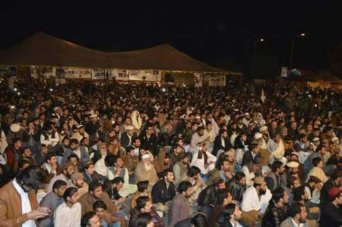- About
- Topics
- Picks
- Audio
- Story
- In-Depth
- Opinion
- News
- Donate
-
Signup for our newsletterOur Editors' Best Picks.Send
Read, Debate: Engage.
| located: | Pakistan, India, Afghanistan |
|---|---|
| editor: | Shadi Khan Saif |
The public display of brutal state-force as well as manipulation of hidden forces by the state and non-state actors against candid democratic manoeuvres continue to undermine civic liberties in places like Pakistan and Afghanistan.
During a sit-in camp in Kabul staged to express solidarity with the Pashtun Long March in neighbouring Pakistan, a young man lost his life to an improvised explosive device blast close to the site of the gathering last week. This attack was aimed at the peaceful protestors who were doing nothing unlawful but gathering in a civilised manner in support to their brethren in neighbouring Pakistan, currently in the face of decades-long state-oppression.
Eleven other participants of the ‘Kabul Parlat’ were wounded by the blast, which has so far not been claimed by the Taliban or any other group; the forces behind this attack chose to stay in the dark. This heinous attack sends a clear message to the peaceful agitators: that their endeavour to raise voices and momentum for the oppressed Pashtun people, particularly of the tribal belt between the two countries, is not approved by certain forces who aren't hesitant to use violence in return for silence.
Decades after the end of the British-colonial rule, this tribal belt is still governed with the draconian laws of the bloody past in the country.
In Pakistan, where the law and order situation is relatively better compared to Afghanistan, the participants of the Pashtun Long March are facing legal as well as security challenges. The young organisers of this moment are demanding an end to state-oppression in the tribal areas, and in an aim to expand their agitation campaign within the country, the grip around them is tightening.
One of the state’s pawn, police officer Rao Anwar – the main culprit behind extra-judicial killings of tribal Pashtun youth in the port city Karachi that sparked the Pashtun Long March, continues to enjoy unannounced impunity despite the presence of mounting evidence against him.
Elsewhere, military jets and helicopters of the Pakistan Air Force entertained local and foreign state-guests at a carefully orchestrated parade in the capital Islamabad last week. These are the same jets and helicopters that were used to pound bombs over hideouts of the suspected militants who were once, and continue to be, used for the policy of so-called strategic depth in neighbouring Pakistan and India.
Photo: Twitter, Pashtun Long March
